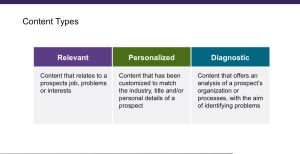Tim Matthews's Blog, page 6
March 14, 2016
A Step by Step Guide to Building an LDR or SDR Team – Part 1 – Strategy and Structure
Estimated Reading Time: 4 minutes
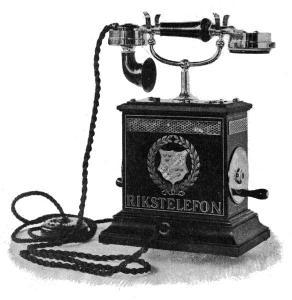 Sales Development Reps (SDRs) and Lead Development Reps (SDRs) are not new. But they are a hot topic right now, especially in the SaaS and Cloud marketing circles I frequent.
Sales Development Reps (SDRs) and Lead Development Reps (SDRs) are not new. But they are a hot topic right now, especially in the SaaS and Cloud marketing circles I frequent.
With all the buzz, I’m surprised how few people truly understand proper strategy and structure for these roles. Quite often, these teams underperform because the up-front thinking has not been done.
In this two part series, I present a checklist for doing it right. I’ve worked with and set up several SDR and LDR teams over the years, supporting both inside and field sales. I’ve seen it done right and done wrong. I think I finally have the formula. Here are your first four steps.
Understand Your Objective – Sounds obvious, but I’ve seen a poorly defined mandate for an SDR or LDR role cause all kinds of confusion and reduce effectiveness. So, decide on your objective. Is your aim to better qualify leads and free up rep time for calls and meetings? Or are you looking to get more meetings for reps in their assigned territories, or perhaps in their assigned account list. Be careful if you said “all of the above,” as these are very different activities that different skill sets. Another way of looking at this question is to ask whether you need better qualified leads, or more leads overall.
Decide on LDRs, SDRs, or Both – Your objective(s) will clarify your strategy, and help decide who to hire. The job of an LDR is to better qualify existing leads. Their focus is on handling the inbound – in other words, qualifying leads that are already coming in. The job of an SDR is to focus on outbound, namely prospecting: “I need a meeting with the person in charge of buying welding robots at Ford.” LDRs should work for marketing, as they are helping with the quality of leads marketing is generating. SDRs should work for sales, as they are working outbound, and are typically assigned to a rep or a territory. You may need both an LDR and SDR function in your company, as I have in my current role.
Build Consensus and Buy In – The two sticking points I’ve seen in setting up an LDR or SDR team are 1) uncertainty over the ROI, and 2) a struggle over the reporting structure. A good benchmark for ROI is Marketo, who themselves expect a 20x ROI from their SDR teams. But it will vary by company. If you can’t convince your CEO or VP of Sales using these, then I recommend running a pilot using a third party firm. There are a lot of telemarketing and sales appointment-setting firms to choose from. They will never be as efficient as your own people, but they are easy to hire for a fixed monthly amount. I did this for the LDR function in my current role and was able to prove that the lower-tier leads the reps never had time to get to were valuable, and the pilot was ROI positive after six months, at which time we decided to hire our first in-house LDR.
Regarding the reporting structure, I think once you have a clear definition of objectives and the role of the LDR and SDR, the struggle over reporting diminishes. It’s when you are not crystal clear on objectives that problems start. Think of it this way. It’s really hard for a head of sales to argue that lead qualification is not a marketing function. And this is exactly the role of an LDR. Likewise, a head of sales does not typically want anyone from marketing prospecting, as this is a sales, and hence SDR, role.
Set Your Targets – Those of you who have read my blog over the years know that I am big on numbers. Numbers are specific and irrefutable. That’s why I like funnel math. SDR and LDR goals should be tied to the funnel you use to drive your business. Here’s how to do it.
LDRs – Decide how many qualified leads you need LDRs to convert and pass to sales. What I like to do is carve out a percentage of my overall funnel for the LDR role, say 10% of marketing qualified leads (MQLs) will come from LDRs. Further, I usually have LDRs focus on the lower quality leads that need more development, like white paper downloaders or webinar attendees. I then calculate how many MQLs are needed to make up 10%, and this is their target (In part 2, we’ll get to calculating activities (calls/emails) needed to his this number.)
SDRs – Decide how many meetings your SDRs need to set to contribute the number of opportunities (sometimes called Sales Generated Leads, or SGLs) you want your SDR team to contribute. You may need to estimate a close rate, as you may have no experience with the role, and success rate will vary widely by company, as the product and buyer may be quite different. You can find some good resources, like this report from OpenView, that give industry averages you can start with.
Hire the Right Profile – Given what we’ve covered already, it’s no surprise that LDRs and SDRs can be quite different human beings. LDRs call and email people who have already expressed an interest in your product. It’s an easier (though not easy) interaction. LDRs are generally assisting and nurturing. SDRs, on the other hand, are prospecting, often cold calling. You want hunters who can handle rejection.
Trish Bertuzzi in her book, The Sales Development Playbook, also makes a great point about differences in career aspirations. SDRs are usually considered reps in training, and most want a career in Sales. LDRs may want to move into sales, though many move on to marketing specialist roles. Trish recommends building out career paths for LDRs and SDRs, and showing new hires where they can go, even going so far as to include career path in the job specs your company posts, to show potential candidates that your company cares about their progression.
You now have a strategy, and depending on your objective, a plan for an LDR or SDR team, of both. The clarity on the role informs the structure of the team, helping alignment between sales and marketing. If you have gotten this far, you are ready to either run a pilot or hire your first development reps.
Next we move on to hiring the right people and making them productive. Part 2 will cover managing and measuring LDR and SDR teams.
What do you think? Did I miss anything? Tips to share?
February 29, 2016
Problem First, Not Product First: How to Hook Your Buyers Problem-Solving Content
 Sometimes you hear something and think, “I heard that five years ago. Ten years ago. How is that still a problem?” Now, I’m not talking about global warming or peace in the Middle East. No, I’m in marketing world here, and specifically, talking about the old saw “sell solutions, not products.”
Sometimes you hear something and think, “I heard that five years ago. Ten years ago. How is that still a problem?” Now, I’m not talking about global warming or peace in the Middle East. No, I’m in marketing world here, and specifically, talking about the old saw “sell solutions, not products.”
Marketers have been told to focus on solutions countless times. So why are marketers are still focusing on product. We marketers are human, after all, and the problem with adages like this is that people tune out when they hear them. But the adage is still true. How do we change?
Let’s take a different tack on the maxim, and substitute problems for solutions. Rewriting the maxim, it becomes “write about problems, not products.” Here’s how you put it into practice.
For those who are building websites or writing blogs, I want you to think about how you can make your copy problem-oriented, rather than product-oriented. Online, buyers are searching for ways to solve their problems, and your content should answer their search. Save the product content for further down the funnel, after you have hooked them.
The need for problem-oriented content struck me in a recent sales training session, where the trainer was teaching sales reps to dig down below what he called “level one pain.” Level one pain is a buyer’s technical, or literal, problem. The WiFi router is not showing up on my iPad, for example. Level two pain – going a level deeper, he explained – is the the buyer’s business problem. If I can’t connect my iPad to the WiFi, I can’t check my email. The third level of pain is personal pain. What happens if the buyer doesn’t solve that business problem? If I can’t read my email, I can’t respond to my boss, and he will think I’m not doing my job.
Think about your buyers, and their personal pain. Do they never see their family because they are always working? Do they get fired for not doing their job? Do they not get a promotion? Understanding their ultimate personal problems will allow you to create poignant content, as opposed to bland stuff about your product. Running a marketing team, I find substituting problems for solutions makes for a more clear-eyed discussion on content strategy.
Bought in and ready to adopt the problem-first mindset? Here’s how.
Step one: Take a look at your website. Maybe you’re already writing problem-oriented content, in which you case you can stop reading this blog and go do something more productive. I have no problem I can solve for you. If, however, you notice that your website is all about your products, then read on.
Step two: Figure out what the problems are that your buyers are trying to solve. What is their pain? Don’t stop at level one; go all the way to personal pain. There are many ways to do this. You can, knowing your buyers, conduct buyer persona interviews and ask your buyers directly, “What are your most pressing problems?” You can ask your salespeople, “What are the business problems that our customers are trying to solve? What was at risk for them if they didn’t solve their business problem?”
Step three: With the list that you’ve ever gleaned from customers or salespeople, write out some problem statements. What’s to be gained from solving these problems? Then take a look around. Do your own manual searches. Use SEO tools to look at search volumes or search patterns or trends around phrases associated with these problems. Then, with that thorough understanding, boil it down to two, three, four, no more than five problems that you solve. It’s unwieldy for a team if you have more. Take a look at your home page and figure out a new design or just new copy that address the top problems. Then look at your blog and constant calendar and next to your content is aimed at solving those problems.
Step four: Conduct some A/B testing. Use a product like Optimizely on your homepage, and if you’re not sure which of those problems is the biggest try them all out. See which one causes your conversion rates to increase. I would say if none of them do, then perhaps you haven’t really figured out the problem that you solve for your buyers.
Getting inside the mind of your buyers, figuring out their problems, and figuring out how to address those problems with problem solving content on your website should all you to have a more productive website and, ultimately, sales force. If you continue putting product in front of problem in your marketing, you might experience some level three pain yourself.
How about you? Is your content problem oriented?
February 22, 2016
Content First, Not Campaign First: Four Steps to Make Sure You Don’t Fall into the Empty Campaign Trap
 I was speaking to a colleague recently who expressed a common lament. She had launched a beautiful looking marketing campaign three months prior, and it wasn’t working. Nobody was clicking. It looked great. It was running in the right places, and she couldn’t understand what was happening. I had seen this before, so, channeling Click and Clack from Car Talk , I asked her one more question to confirm what I suspected her problem was. “How did you come up with the campaign?” I asked. Here it came.
I was speaking to a colleague recently who expressed a common lament. She had launched a beautiful looking marketing campaign three months prior, and it wasn’t working. Nobody was clicking. It looked great. It was running in the right places, and she couldn’t understand what was happening. I had seen this before, so, channeling Click and Clack from Car Talk , I asked her one more question to confirm what I suspected her problem was. “How did you come up with the campaign?” I asked. Here it came.
“Well, we hired an agency. We sat in a conference room a couple times over a few weeks, and the agency came back with some concepts, and we narrowed them down to the final two,” she told me. “Then we showed them the CEO. He liked the one with the cheetah, so we went with the cheetah. It looked really cool, and we thought it was going to be great, but it didn’t work.”
As I suspected. This is the common trap of building your campaign before you plan out your content – what I call an “empty campaign.” Shiny on the outside, hollow on the inside. Think about it. How many buyers wake up and think, “I’ve got to find me a cool campaign today,” or “Something with a car and a really sexy girl is what I’m looking for,” or whatever? What buyers really want are solutions to their problems. Content, in the form of how-to articles, instructive videos, comparisons guides, will provide those answers. The big mistake my colleague made was building her campaign before she had a content strategy.
For those of you who are still doubting if content before campaign is the right order, think about campaigns you remember. The only campaigns people remember cost a lot of money. Apple, for example, spends over one billion dollars a year. So unless you work at Apple, or Coke or Budweiser, you don’t have that kind of money. So go where your buyers go – Google. Be there when they are searching for a problem they’re trying to solve. Whoever has got the content, whoever has got the articles, the how-to’s, the videos to solve that problem is the one who will gain the views of the buyers.
I saw this problem myself first hand working at a larger company with an entire campaign team, and working at a company where I ran marketing where I created a theme for the year that was cool looking but didn’t move the needle. At the larger company, my team was constantly asked to create new content that was then shoehorned into templates by the campaign team. That’s inside out thinking. At the company where I ran marketing, the campaign was nothing more than an image library we’d slap on tradeshow booths and certain new brochures, but was not nearly as effective as the well thought out content we wrote for our key buyers.
You’ve got to actually know what your buyers are looking for, and you’ve got to produce the content. Then, after you have that, you can decide on whether you need a campaign theme for the year, or whether your content and your brand will win the day.
How do you go about doing this? Here are four steps:
Step One: Nail your buyer – Do not go past step number one if you don’t know exactly who’s buying your product. I’ve written about buyer persona research before, and creating content without a solid understanding of the buyer is a common mistake because it takes a lot of work. It takes a lot of debate. Sometimes you can’t agree on who your primary buyer is. Figure out if you are selling to CEOs, paralegals or auto mechanics. Whoever it is, be very, very specific. That’s the first step in building great content that is relevant and useful because you’ll know exactly who the person is, and what their problems are.
Step Two: Write Your Mission Statement – I stole this from content marketing heavy Michael Brenner. He had this great and very simple idea. Write a mission statement for your content. Again, be very, very specific. “We are writing useful how-to articles for lathe operators who want to enhance their skills.” Or, “We are writing for harried IT operations staff who are dealing with downtime issues.” Or maybe, “We are writing useful and educational articles to help paralegals be more efficient with the aim toward getting a promotion.” Whatever it is, the more specific you can be, the more on target you’ll be with your buyer, and the more of an authority your domain will become, and you’ll rank higher in Google.
Step Three: Create a Content Calendar – A content calendar is a convenient way to track who is writing what, and for what outcome. Be very specific about which buyer you’re after. You may have multiple buyers, and that’s okay. What type of content it is, what action you want them to take after reading the content, and of course, who the author is going to be, whether it’s somebody inside your company or outside your company. With that in place, you’ll be able to execute on a very targeted, and probably very good content marketing campaign.
Step Four: Decide If You Need a Campaign – Would it move the needle? Do you have the money to make it matter? Maybe great content plus your brand will be enough for people to trust you and come your way. Of course, they’re going to find your content. If you think you want a campaign, then I want you to send your mission statement and content calendar to your agency before they ever come into your office. Have them study these for at least three hours. Then, using our example from above, they would come in with ideas that revolve around paralegals and job advancement.
Using this process, my colleage would probably never have come up with the cheetah theme. And how bad would that be? It might be something more professional, but now your campaign ties nicely into your content, and it will reinforce what you’re trying to do. Otherwise, you’ll have an empty campaign. It looks shiny. You’re all impressed with it. It doesn’t yield results. It doesn’t move the needle.
Don’t be that Director of Marketing or CMO that just spent half a million dollars on a campaign that looks great hung on the marketing bulletin board, but doesn’t do anything outside the building. Make sure you know your buyer and what they want. Put content first before you even think about hiring an agency to build that campaign.
February 1, 2016
Organic Traffic Isn’t Free: How to Dispel this Common Misconception
 I was in a meeting recently with a web design agency. We were discussing a new site, and how we would be generating leads, when he made the following comment, “Of course, you want to get lots of that free organic traffic.”
I was in a meeting recently with a web design agency. We were discussing a new site, and how we would be generating leads, when he made the following comment, “Of course, you want to get lots of that free organic traffic.”
I thought to myself, I’m not going to hire this guy. He has no idea what he’s talking about. Why did I think that? Because SEO is not a one time, set-it-and-forget-it operation. Growing organic traffic takes a lot of work. Lots of staff and agency time. That costs money. It is far from “free.”
Getting a lot of great organic traffic is a weekly job, maybe even a daily job. It’s not just about keywords on your website anymore. It’s about having great content. Having great content takes a lot of work. You’re either paying for your employees’ time to research it, write it, edit it, and lay it out, or you’re paying a third party agency to write it, and then you edit it, and then lay it out. Or perhaps you’re recruiting experts to guest blog for you. In any case, producing the content to get that organic traffic takes a lot of time and money.
Secondly, you want people to link to your content. Getting people to link to your content is also a lot of work. This is so called offsite SEO. You need to spend time researching who the influencers are. Guest blogging on their blog. Placing articles in niche publications that have a strong domain authority. Making sure that your content is relevant enough for them to agree to link back to. This may, in fact, be somebody’s full time job; or perhaps, as we do, you might pay an agency to do it.
Then, of course, once you write great content, you want to promote it as much as you can. There’s a great Whiteboard Friday by Rand Fishkin talking about content amplification. This is both paid and organic amplification. We’ll leave paid aside for now, but, again, organic amplification takes a lot of time. It’s almost like a sales job. Finding influencers, currying favor, asking them to link to your content. Asking them to guest post on your domain, and then in reciprocation, on their domain… you get the picture
Why is it important to know that organic traffic isn’t free? I think there are two reasons. First, as an individual marketing practitioner, if you are operating under the fallacy (or, at best, this outdated mindset) then your competitors are having a field day within your content domain. Don’t let this happen to you. Make sure you’re investing enough in maintaining your SEO. Otherwise, it simply won’t last and you will tumble down, down, down the SERPs.
Second, you’ve got to make sure that whoever controls your budget understands what you need. Hiring people to write, though perhaps less expensive than hiring developers, is still expensive. You need to find good writers. You need to find good editors. You need to find good layout people. Perhaps you need to find good graphic artists to produce an infographic that really crystallizes what you’re talking about. This costs money, and your CEO, or CFO, or your VP of marketing needs to understand it. So, dispelling this myth that organic traffic is free, it’s in your best interest to get the money that you need.
The last thing I’ll say is this. I invest in almost every marketing channel you can think of as a head of marketing, but I see the writing on the wall. I’ve woken up and smelled the coffee. Paid distribution and advertising, while necessary, are not as effective as they used to be. If you’re not investing in organic content, and promotion via SEO, you’re going to be behind the eight ball.
So don’t be that person. Educate your team. And if you ever hear an agency tell you that organic traffic is free, I want you to think twice about hiring them.
January 6, 2016
Five New Year’s Resolutions for Marketing Teams
Good heads of marketing are always looking for ways to make their team perform better. But, with no shortage of things to do, layering on more – more planning, more training, more anything – can make any CMO feel a little guilty. What to do?
One solution is to seize on resolution season. Create a quick-win New Year’s resolution for your team. By making it small and completing in January, your team can enter the year a little bit smarter and more energized. Here are five easy resolution ideas you can use.
Give Your Marketing Program an Annual Performance Review – You give your people an annual performance review, right? How about your overall marketing program. Would you give it a raise? A promotion? Sometimes we’re so busy measuring individual marketing efforts we fail to see the big picture. So step back from that redwood and take a look at the whole grove. Just for fun, rank your marketing program (or department) using the same system you use for giving annual performance reviews. Share the results and discuss.
Be the Buyer for a Day – I’ve written about this before. Spend a day acting like someone buying your product, both from your company and your top two competitors. Do the product research. Fill out the forms. Sign up for the demos. Call the published sales phone numbers. This exercise takes no prep and you can find out how you stack up. Plus, it’s a lot of fun and gets people motivated.
Create Some Top Ten Lists – Do you know your top ten most read blog posts for the last year? How about your most shared? Or your top performing eBooks? Freshen up your weekly team meeting by sharing some top ten lists. Have some fun with it, then discuss how you can create more assets that are like your top fives.
Steal Two Great Ideas – As good as you may be, you can’t have all the good ideas. As I am wont to say, it’s not the job of a CMO to have all the great ideas, just to recognize them. So go outside your four walls and steal a few. (It’s okay, everyone does it.) Have each member of your team bring their favorite to your weekly meeting, then pick one to purloin implement. If you need some inspiration, I highly recommend Steal Like an Artist by Austin Kleon.
Set Professional Development Plans – Your marketing is only as good as your people. How are you improving them? I like to set a personal development goal for each employee. Make it straightforward and actionable. Need to become a better public speaker? When are you taking Decker training? Want to be seen as an SEO guru? When are you giving the talk to the local meetup? Better yet, when is your book coming out? Make sure everyone one your team (including you) has a goal and an action plan.
So, don’t wait. January was named for the Roman god Janus, who had two faces, one looking forward and one looking backward. Make sure you spend this week looking backward, reflecting on what you could have done better in 2015, and set a small “January resolution” to get your team off on the right foot in the new year.
Care to share your own 2016 marketing resolution? Have another idea to share? Let me know.
December 29, 2015
Startup Companies that Say They Do No Marketing Are Full of It
I was recently at a tech marketing conference in San Francisco, and I once again heard a line from a founder that made me sigh. The trope used to make me groan, but I’ve heard it so often that now I merely sigh and shake my head.
Here’s the line: At our startup we don’t do marketing. We just build a great product, and the rest takes care of itself. Sigh. It’s just complete BS. Here’s why.
Most people don’t understand that product is an essential component of marketing – the first of the 4 Ps of marketing, defined by Jerome McCarthy decades ago. They are as relevant now as they ever were. The other three Ps are price, place and promotion. We’ll get to how these are applied in just a minute, but the reason many founders claim not to be doing marketing – in addition to bravado – is that they don’t really understand what marketing is. There is more involved in marketing than writing press releases and paying for advertisements. Marketing starts by understanding what customers need or want, and building a product to suit that need or want.
What’s really going on at these startups in marketing denial? Let’s take a closer look through the lens of McCarthy. First at product. You’ve got to build the right one. So, a founder making the claim that all they do is build a great product is saying that her company…does great marketing (or at least the first step in great marketing).
The second, place, is where you sell your product. Do you sell it online? Do you sell it in retail stores? Or  are they your stores, as with Apple’s go-to-market strategy? Deciding where you’re going to sell a product is as important as anything else you do and how you approach the market, a.k.a. marketing.
are they your stores, as with Apple’s go-to-market strategy? Deciding where you’re going to sell a product is as important as anything else you do and how you approach the market, a.k.a. marketing.
The third aspect – price. I hear a lot about freemium as if it’s a brand new thing. Giving stuff away for free is a tried and true marketing tactic. It’s been used for a long, long time. Freemium is a marketing strategy. Getting people to try your product for free, avoiding buyer remorse, and therefore exposing it to more people who might not otherwise even give it a whirl? That is a marketing strategy revolving around price. Subscription pricing, commonly used by SaaS vendors, reduces sticker shock and allows faster transactions by shifting the buying center from IT to the line of business. Or, how about the App market and in-game purchases – is this not the old razors and razor blades strategy?
Finally, promotion. This is the very limited, narrow view of marketing that most startups and their boards think of. Of course you’ve got to do promotion, but it’s clear that some people don’t think that promotion includes thing like blogs or practicing SEO. These are newer online tactics, but they’re promotional tactics. These are how people find your product and how you promote your company. It doesn’t matter that you’re not doing press releases, or you’re not going to large trade shows. If you go to meetups in San Francisco or in New York or in London, you are going to events filled with potential buyers. It’s the same technique, merely a different venue.
If you run a startup, think more about marketing writ large, not just promotion The 4 Ps are here to help you. You may no longer practice what you might call “traditional marketing.” It’s okay if you shun the press release, don’t believe in big events and don’t sell through a distributor. But, think about how you can use the 4 Ps to further the reach and exposure of your product.
Take the example of a fledgling hardware company that years ago started with a great product but needed a way to break away from the pack. There was this new medium called radio. The founder decided that his company would be the first company ever to advertise over the airwaves. That was in 1923, and now Bulova (since acquired by Citizen) is one of the top ten watchmakers in the world.
What do you think? Believe you can grow a startup without marketing?
November 17, 2015
Joel York on Agile Marketing
I don’t do a lot of interviews here in Matthews on Marketing, but I recently caught up with an old marketing comrade, Joel York, to find out more about his new agile marketing project.
TM: To set some context, what is ‘agile marketing’?
JY: Agile marketing is a set of agile marketing management disciplines that maximize marketing’s ability to respond rapidly and effectively to change. The basic premise is that if you are marketing in an industry characterized by rapid change and shifting marketing opportunities, as most of us are today, then the marketer that can move the fastest wins. Another way of putting it is that the goal of agile marketing is to transform change from a challenge into a strategic weapon.
Agile marketing started in the Internet industry as an offshoot of agile software development, but its roots run much deeper into agile manufacturing and total quality management. As a career CMO, it’s the first serious attempt I’ve seen at improving how marketers get their jobs done. If you think about it, dissertations have been written on how to get the most out of sales, engineering, manufacturing, service, etc., but marketing remains sorely neglected.
TM: Is this just a SaaS concept, or can it be applied to any marketing team?
JY: Agile marketing is most definitely not limited to SaaS. It can improve the performance of any marketing team. In fact, it can improve the performance of any marketing function from product to public relations.
Today, agile marketing has seen the broadest adoption in social media and content marketing, because these areas are natural production lines. As such, they have been able to adopt off-the-shelf methodologies like SCRUM. The canned methodologies, however, were not designed specifically for marketing. My feeling is that we marketers need to focus on the core agile marketing disciplines and apply a little marketing creativity to evolve new methodologies that better fit the unique requirements of marketing.
TM: What will a CMO gain from trying agile marketing? And how would a CMO explain the benefits to their CEO?
First, agile marketing not makes your marketing more nimble, but it also imbues your marketing with a systematic and data-driven focus on the customer. Something we marketers all say we should do, but then we quickly forget it when we need to get some work done. Agile marketing builds customer focus into the work process, so it becomes a daily habit. The value of everything marketing does is measured through the eyes of the customer.
Second, let’s break down this idea of making change strategic weapon. If your average marketing project takes a month, then the quickest you can capitalize on any marketing opportunity is 30 days. If your marketing planning cycle is quarterly, then the quickest you can change your plan is 90 days. Agile marketing aims to shrink these timeframes dramatically. Planning cycles are weekly and average project size is daily, or in the case of social media perhaps even hourly.
Finally, most marketing departments have very poor memories. Agile marketing provides a method to the madness we call marketing. This rigor enables organizational learning and continuous improvement. Marketing performance becomes more consistent, more predictable and constantly moving up and to the right.
TM: You’ve obviously spent a lot of time thinking about agile marketing and interviewing practitioners. What can go wrong? What should people watch out for.
JY: I think the easiest way to go wrong is to see agile marketing as one of these canned methodologies like SCRUM, turn it into a big change management effort, and then apply it where it isn’t applicable. For example, you can’t put on a major product launch with SCRUM, it just won’t work. Product launches are big bangs. If you go into agile marketing looking for a recipe, you’ll probably find half your marketing team loving it and the other half hating it.
Marketing projects come in a staggering variety, from tweets to trade shows.The stronger approach is adopting agile marketing the agile way: a little bit at a time.: a little bit at a time. And, focus on mastering agile marketing disciples over implementing a specific methodology. Let’s take our product launch example. You can’t trickle out a product launch, but you can build up to the final show with small iterative projects. That way if things change along the way, such as the launch date moving in or out, then you can easily adapt your marketing plan without throwing away good work. You can also collaborate transparently with sales, engineering, etc. to create a better product launch.
TM: Tell us about your project and why you felt you needed to build it. There is certainly no shortage of marketing technology out there. Why another?
JY: You are absolutely right. There is no shortage of marketing technology. Unfortunately, 99% of the marketing technology out there is a) an individual contributor tool and b) automation focused on demand generation. There is virtually nothing focused on the people side of marketing. The best you will find is some generic project management tools. Here is the acid test: Name one marketing system everyone in marketing logs into in the morning. There is no system of record for marketing. No salesforce.com. No Zendesk.
Surprisingly, most marketing departments spend more on people than they do on programs. If you are a very large company with a big branding budget or you are selling simple consumer goods or services, you might spend more on programs. But, if your product has any level of complexity, you will be spending most of your money on product marketing, content marketing, social media marketing, public relations and so forth. And, that’s people. Unfortunately, we give very little attention to managing that investment. The Markodojo marketing management platform blends marketing management basics, agile marketing best practices, CRM and Internet collaboration to span the wide range of marketing work and help marketers reach out to customers, sales, and all their other relationships outside of marketing to increase marketing agility and performance.


October 24, 2015
Diagnostic Content: How to Boost Conversion and Increase Customer Trust with Problem Solving Content
Last week, I had the pleasure of speaking at the 2015 MarketingProfs B2B Marketing Forum. Here’s a condensed transcript with my slides of my talk, plus a link to the whole presentation at the bottom.
The Concept:
 Everyone here has had what I call a “diagnostic experience”. You’ve gone to the doctor, brought your car to the shop, gone to a golf or tennis pro, you’ve sought out the advice of a professional to try and help you understand your problem and give you advice on how to fix it.
Everyone here has had what I call a “diagnostic experience”. You’ve gone to the doctor, brought your car to the shop, gone to a golf or tennis pro, you’ve sought out the advice of a professional to try and help you understand your problem and give you advice on how to fix it.
You’ve gone there because you trust the person and they have answers, and some of the most effective advice you’ll probably ever get. Even if it’s bad news, “Sorry Tim, that transmission is going to cost $5000,” or “Hey Tim, your golf slice is really, really bad. It’s going to take a while for you to fix that.” You ultimately appreciate the advice, and, ultimately will try to act on it.
So I ask you this, with all the content that we’re putting out, why are we not putting out more what I call “diagnostic content,” content designed to help customers understand and solve their problems? I think that a lot of people think that it’s hard. I think there are some who think that customers don’t trust vendors, but I’ll challenge you, and show you today how you can actually create this content very cost-effectively. Not only cost-effectively, and use it not only to convert leads, but to gain the trust of your customers.
Defining Diagnostic Content:
The last kind of diagnostic content is really powerful because it’s designed to help me solve my problem. It’s both relevant and personal, and designed to get at something that’s in my self interest. It might say something like, “Tim, other staffs covering the Silicon Valley are out-performing your demand gen. Find out why.” Huh, I didn’t know that. I mean, I’m not sure if it’s true or not, but I’d like to find out. I would probably open that email, and if it were a reasonable offer I might actually sign up or call the person back. That’s the kind of stuff that’s in my self-interest, very relevant to me but also designed to solve a problem, and that’s key to diagnostic content.
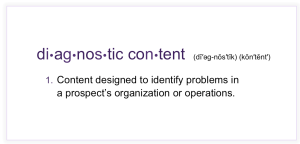 I’m a bit of a Wordnik. If you dig into the definition of diagnostic, it comes from the word “diagnosis” which is from the Greek, which is “to understand fully”. That’s really important because that’s what you’re doing, you’re helping someone to understand their problem fully.
I’m a bit of a Wordnik. If you dig into the definition of diagnostic, it comes from the word “diagnosis” which is from the Greek, which is “to understand fully”. That’s really important because that’s what you’re doing, you’re helping someone to understand their problem fully.
What’s really important is that customers can’t understand their problem fully. Why is that? Well, they’re in their own company, they don’t have the data that you probably have from the industry, or from your systems, or from best practices, so don’t sell yourself short. That bias I talked about against diagnostic content preventers is misplaced because you actually are the experts in whatever — cupcake manufacturing, paint manufacturing, SaaS advertising techniques. Whatever it happens to be, you know, because you have hundreds or thousands of customers, and you can take that knowledge and apply it to help this customer know fully what his or her problem is. That’s really key when it comes to diagnostic content, and creating content that’s really valuable.
Examples:
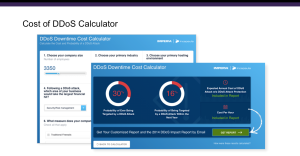 Here’s something from my current company, we’re a cloud service. You don’t need to know the details, but a DDoS is a kind of attack where the bad guys flood a website to try and slow it down, or take it down. Everyone knows they’re bad, but nobody really knows how often they’re going to happen and when they do hit, how bad is it? How much does it cost me? In fact, we’re in the business and we didn’t exactly know. We knew they were bad, we couldn’t actually tell somebody it’s going to happen; twenty-seven percent of the time it’s going to cost you, whatever, $100,000 per … so we commissioned a study. We hired a survey group. They went out and they found 300 buyers like our customers, IT operations people and we just asked them, “Have you ever had one?” “What did it cost?” “How often do they occur?” … and so on.
Here’s something from my current company, we’re a cloud service. You don’t need to know the details, but a DDoS is a kind of attack where the bad guys flood a website to try and slow it down, or take it down. Everyone knows they’re bad, but nobody really knows how often they’re going to happen and when they do hit, how bad is it? How much does it cost me? In fact, we’re in the business and we didn’t exactly know. We knew they were bad, we couldn’t actually tell somebody it’s going to happen; twenty-seven percent of the time it’s going to cost you, whatever, $100,000 per … so we commissioned a study. We hired a survey group. They went out and they found 300 buyers like our customers, IT operations people and we just asked them, “Have you ever had one?” “What did it cost?” “How often do they occur?” … and so on.
They produced their report, but then we took the report, turned it into a calculator. Six simple questions that someone can answer, and out comes a risk report. It’s very simple, and now they know that on average, it costs $40,000 and it’s fairly likely to happen. Now, we made a mistake with this one because we actually gave them all the information without a form fill, they just answered the questions. We realized that that was very well viewed, but it didn’t convert, didn’t actually capture the lead. What we did was, this is a key piece, a key learning from us is, give them a taste. Give them a summary, if they want the full report, then they fill out the form.
This cost us $15,000 to make pretty and have work well on mobile devices. It’s so far gotten 15,000 views, 5,000 leads, so about $3 per qualified lead, and I’d say these people are pretty well qualified. If they take the time to fill out the report they want to know the answer, and then download the PDF version of it, they’re probably someone who is pretty ready to talk to your sales people.
This next example, you’ll see this theme of calculators with me . It was from a couple of companies ago; a similar thing, we were studying the cost of a data breach. Anybody here shop, or used to shop at Target or Home Depot, or T.J. Maxx, any of the big box retailers that were struck by a data breach of your credit card numbers that were potentially stolen? We all know that it cost Target a lot of money. Their CEO lost his job, the CIO lost their job. For a mid-sized company, they didn’t really understand what it was going to cost them. They couldn’t afford to hire a forensic accountant to go back and diagnose what happened. We hired a researcher who was not very well-known at the time, who specialized in this. We had him go out and do confidential research with, at the time, eight companies which then grew to over 200 companies. After several years of doing this, we asked him to build us a model. He built us an Excel spreadsheet model that essentially laid out the risk of somebody having this happen to them. We then took it and built it into this calculator that you see here, a bit more extensive, 13 questions, and out comes a report similar to the last example.
. It was from a couple of companies ago; a similar thing, we were studying the cost of a data breach. Anybody here shop, or used to shop at Target or Home Depot, or T.J. Maxx, any of the big box retailers that were struck by a data breach of your credit card numbers that were potentially stolen? We all know that it cost Target a lot of money. Their CEO lost his job, the CIO lost their job. For a mid-sized company, they didn’t really understand what it was going to cost them. They couldn’t afford to hire a forensic accountant to go back and diagnose what happened. We hired a researcher who was not very well-known at the time, who specialized in this. We had him go out and do confidential research with, at the time, eight companies which then grew to over 200 companies. After several years of doing this, we asked him to build us a model. He built us an Excel spreadsheet model that essentially laid out the risk of somebody having this happen to them. We then took it and built it into this calculator that you see here, a bit more extensive, 13 questions, and out comes a report similar to the last example.
I want to point out a key difference here. You see that yellow box? That is the customer’s answer, and then the high and the low. This is the customer able to see themselves compared to their competition, or compared to their peer group. It’s really important when you build these tools, if possible, to build in a benchmark because it converts better, and it’s definitely a trigger for action. If somebody is under-performing based on a peer group, it’s showing them their pain. Customers don’t often understand that they’re actually in pain. This cost us $25,000. I hadn’t worked with Symantec for several years. Last I left, it had 7,000 leads. My rough math says that by now, there should be between 25 and 30,000 leads because it’s still running. The beautiful thing about these by the way, is they’re very low maintenance; every year we just change the numbers.
These things can be labor intensive up front in terms of having a report done and building the tool, but if you actually look at it in hindsight, very, very effective. The other beautiful thing about these tools is we push these PDFs into sales force, and so when the sales guy is getting ready to make a phone call to this customer for the first time, he reads the report. He knows the industry, he knows how big the company is, he knows where they think they’re weak, he knows how to compare to the competition, so all of this information is great for your sales team. Also by the way, a little trick: if you build these tools, you can make your forms shorter. Think about that. What we did was, it was actually key to understanding the risks of knowing the industry, company size, country, if it had a certain job title employed in their company. You get all this information in the survey itself, that you can push transparently the sales force, without bothering your customers with long forms. Our forms are only four or five fields long because we had everything else we needed, and the sales guy had a great tool.
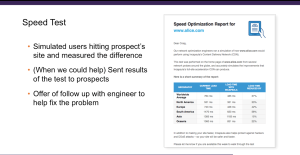 Okay, last one I’ll show you is a bit different. This is one I call ‘proactive’ vs ‘promoted’ diagnostic content. What do I mean by that? The previous two examples we’ve produced, and then we advertise to our customers via email and pay-per-click ads, “Hey, find out your risk”, and it worked really well. In this case, we actually ran a simulation for the customers without their even knowing it. We took the ones out that we couldn’t help, and they probably appreciated that we didn’t waste their time having an SDR call them up. The ones we could help, we sent them and email, you see it right here. It says, “We ran a test on your site, and your site can be faster and here are the details.” We showed them the speed across different regions. Now, this got a really good first response, click-throughs and people agreeing to have meetings.
Okay, last one I’ll show you is a bit different. This is one I call ‘proactive’ vs ‘promoted’ diagnostic content. What do I mean by that? The previous two examples we’ve produced, and then we advertise to our customers via email and pay-per-click ads, “Hey, find out your risk”, and it worked really well. In this case, we actually ran a simulation for the customers without their even knowing it. We took the ones out that we couldn’t help, and they probably appreciated that we didn’t waste their time having an SDR call them up. The ones we could help, we sent them and email, you see it right here. It says, “We ran a test on your site, and your site can be faster and here are the details.” We showed them the speed across different regions. Now, this got a really good first response, click-throughs and people agreeing to have meetings.
I will say that this hasn’t converted as well into opportunities, and we realized our mistake about a month in after a couple of meetings. That is, that we tell them it can be faster but going back to self interest, we didn’t tell them how fast or slow they were compared to their competition or their peer group. There wasn’t any real reason to act. “How interesting Incapsula, we could be faster. Let me think about that, good to know.” We’re going back, and we’re actually doing benchmarking so we can send them a new report that says you are faster or slower than your peer group, your industry, the elected top 10,000, whatever it happens to be. We’re pretty confident we’re going to get better results.
Lessons Learned:
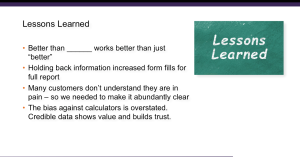 I promised to tell you how you can do this yourself. Let me tell you somethings not to do, or to keep in mind when you’re building out these tools. As I just said, “better than blank” works better than just “better”. Comparing the customer to their peer group, to their competition, to last year, something else is much more powerful and it’s an incentive to act, so make sure you do it. Holding back information increases form fills. It sounds obvious now, but we’d forgotten that. Give them a summary. Don’t rip them off, but then if they want the full report, the full details, they want the benchmark, then have them fill out a form and you’ll know they’re even more qualified. By the way, for those folks who don’t fill out the form, you can always re-target them. We don’t let them off the hook, we re-target them and we do pull some of those people back. Many customers don’t know they’re in pain, so you’ve got to tell them.
I promised to tell you how you can do this yourself. Let me tell you somethings not to do, or to keep in mind when you’re building out these tools. As I just said, “better than blank” works better than just “better”. Comparing the customer to their peer group, to their competition, to last year, something else is much more powerful and it’s an incentive to act, so make sure you do it. Holding back information increases form fills. It sounds obvious now, but we’d forgotten that. Give them a summary. Don’t rip them off, but then if they want the full report, the full details, they want the benchmark, then have them fill out a form and you’ll know they’re even more qualified. By the way, for those folks who don’t fill out the form, you can always re-target them. We don’t let them off the hook, we re-target them and we do pull some of those people back. Many customers don’t know they’re in pain, so you’ve got to tell them.
A lot of people don’t know the risk of a data breach for example, so you’ve got to tell them the kind of pain they’re in. Lastly, as I said, this bias against calculators is overblown. Now, I can spot bogus calculators a mile away. Those that are designed to win, fake off or that are obviously slanted, hone to buy their products. If there’s nothing else in the marketplace. These days there are a lot of niches, there are a lot of gaps because there are so many analyst firms that have gone away or slimmed down. The press has less money, or no money to do this kind of research, and so if you do it in a trustworthy way, you can actually gain that trust and fill that void and become the expert. What you’ve got to do is make sure you’re very transparent about your methodology; lay it all out.
The first example I showed you, that DDoS calculator, the firm that did it for us, they said, “Tim, there’s a lot of math. Let me just send you a summary of what we did.” I said, “No, no, no. I want the full, two-page long description of the methodology, the significance if the statistics. Give me everything because there’s going to be that guy, or the woman that works for the guy, and she’s going to want to know we’re not one of those people, and so give them all the detail. Let them read through it, and if they decide that it’s not trustworthy enough to their mind, that’s fine. You’ll take everybody else that does believe it and they’ll become your customers, or at least your prospects.
The Whole Presentation:
http://www.slideshare.net/timmatthews2011/slideshelf


October 19, 2015
Startup Marketing Essentials – The Whole Megillah
 There is never a shortage of urgent tasks in a startup’s marketing department. How to prioritize? Here are my ten startup marketing essentials to get you on your way.
There is never a shortage of urgent tasks in a startup’s marketing department. How to prioritize? Here are my ten startup marketing essentials to get you on your way.
#1 – The Four P’s
I was introduced to E. Jerome McCarthy’s four P’s later in my career. I wish I had known them earlier. There is no more perfect summation of marketing. Each of the P’s is a lever at your disposal. As a startup founder or CEO, understanding the four P’s will help you know which of the four levers to pull to beat your competition. Learn them.
#2 – Market Sizing and Segmentation
If TAM, SAM and CAGR mean nothing to you, you have a problem. Whether you are creating or disrupting a market, knowing how big it is, and what segments are most ripe for the picking are critical. Read more.
#3 – How to Develop a Positioning Statement
Positioning is sometimes referred to as the fifth P, along with product, price, place, and promotion. Founders spend the formative years of their companies answering a constant stream of questions from prospective employees, investors, and investors: What are you? Is that like so-and-so? How are you different from [insert large company that will no-doubt crush you]? Developing a desired position, and formalizing it with a positioning statement, are critical steps on your way to profit and glory. Read on.
#4 – Building and Delivering the Killer Presentation
Many presentations are, well, not good. If you want to stand out among the other startups and gain more press attention, buzz, investor dollars, and early customers, good presentations can help a lot. And I’m not impressed by war stories about busy execs to create their slides ‘in the cab from the airport.’ Chances are their audience could tell. Do yourself a favor and put in some real prep time and practice. Learn how.
#5 – How to Build a Funnel Model
How many leads do you need, exactly? Don’t know? It all starts with the funnel model. If you are in a startup and your product is ready to sell, you need to model your sales process to understand how much to invest in your sales team and marketing budget. The model also acts as a set of guideposts that will let you know if you are on track to hit your numbers. Learn how to reverse calculate from your revenue target back up through the funnel to visitors on your website. Read on.
#6 – How to Write a Press Release
The workhorse of public relations is the press release. Written in the form of a conventional news story, a press release alerts the media to an organization’s news and presents it in that organization’s point of view. Editors and reporters use facts, quotes, and other information contained in releases to flesh out their stories. Blogs are great, but if you are really going to grow, you need to know how to write a good press release. Learn how.
#7 – How to Build a Website
Every startup needs a website. I’m stating the obvious. So I’ll restate. Every successful startup needs a great website that meets its business goals: awareness, reach, virality, conversion. Building (or rebuilding) the right one takes a lot of effort. Here are some pointers on how you should conceive and plan your site. Read on.
#8 – Lead Nurturing and Progressive Profiling
Leads are the lifeblood of a startup. One common mistake made by startup marketing teams is ignoring leads that are not ready to pass to sales. These leads need to be nurtured – helped along – until they are ready. If you ignore them, you have wasted the money you spent to acquire them in the first place, and paying yet again for brand new leads that may or may not be more qualified. And as you nurture your leads, you can learn more about them, using what’s known as progressive profiling. Grok them here.
#9 – Building a Test and Measurement Culture
You can’t work in a startup these days without doing A/B testing. Multivariate if you are really good. There’s a reason why Optimizely is spreading like digital kudzu. But you can’t just buy software. You need to make testing part of your culture. Here’s how.
#10 – Creating a Sales Playbook
You have released product and are selling it. You want to scale the sales team to really start taking off. How do you make sure all the new guys know how to sell your product. The answer is a sales playbook. A cookie-cutter approach to selling that will work every time. Learn how to build one.
Did I miss any important ones? Does your startup go to eleven?
Startup essentials is a series of excerpts from The Professional Marketer . I’ve pulled out what I think are the most essential skills a founder or a marketer at a startup would need.


September 29, 2015
Startup Marketing Essentials: #10 Creating a Sales Playbook
You have released product and are selling it. You want to scale the sales team to really start taking off. How do you make sure all the new guys know how to sell your product. The answer is a sales playbook. A cookie-cutter approach to selling that will work every time. — TM
 If you ask heads of sales what they desire most in their job, the answer will likely be a repeatable, predictable sales process. The more one deal can look like another, the better a sales manager, director, or vice president can predict the likelihood of a win, and the better his or her forecasting will be.
If you ask heads of sales what they desire most in their job, the answer will likely be a repeatable, predictable sales process. The more one deal can look like another, the better a sales manager, director, or vice president can predict the likelihood of a win, and the better his or her forecasting will be.
This objective is difficult to achieve when different salespeople are selling in different ways. Though every customer situation is unique and every sales rep has a distinctive personality and style, more often than not there are common points in a sale as well as common mistakes or pitfalls to be avoided. Making your sales team aware of the critical points in a sale and how to avoid common mistakes will smooth out the process and improve sales efficiency.
This is where sales playbooks come in. A sales playbook is a collection of one or more sales plays—a series of steps to move an opportunity to a closed deal. The concept is analogous to a football team’s playbook that contains a number of plays for different situations (In contrast to a football playbook, however, sales playbooks should be simple and contain only a limited number of plays.) Whether a company should employ multiple plays depends on the number of products they sell and the range of buyers they sell to.
All playbooks should include three critical pieces. The first is the description of the play. This is essentially a quick overview of the play and how it works, including the market, the buyer profile, and key trends. The second piece is comprised of step-by-step play activities. This information typically is presented as a workflow diagram that displays all of the stages involved in the play as well as the activities associated with each step. The final piece describes the tools and assets by step. This is essentially a list of sales tools and customer assets, mapped to a particular step in the sales play, with guidance on how to use them.
A play starts at the point a sales qualified lead has been handed off to sales, or when a salesperson has created a sales generated lead. The steps of a sales play should be aligned with the sales stages that sales management uses to track progress within their pipeline. These stages are not the general stages of awareness, research, consideration, and purchase that are part of the customer journey. Rather, these are specific stages that sales management has defined for a specific organization, its products, and its customers.
Many of the steps in a sales play are sales fundamentals that focus on qualifying opportunities, discovering specific customer problems, obtaining agreement or quid pro quo from prospects, and preparing to close the deal, also known as “the close.” Each step should be completed in sequence and include a corresponding set of tools that will aid a sales rep in getting to the next step.
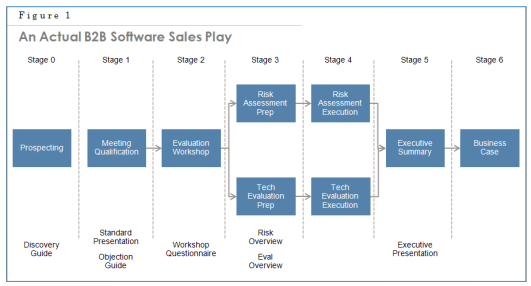 Figure 1 shows a play that was employed very effectively by a team I worked with while at Symantec, generating over $500 million in software sales (I genericized the play to mask some of the team’s secrets). Without giving too much away, the play worked because sales had gathered specific information to qualify the customer, reps obtained certain quid pro quos from the customer in advance, and the security risks discovered by the product were presented back to customers in a compelling format. Sales leaders swore by the play, and they would lower the likelihood of closing a deal if they discovered a rep had skipped a stage.
Figure 1 shows a play that was employed very effectively by a team I worked with while at Symantec, generating over $500 million in software sales (I genericized the play to mask some of the team’s secrets). Without giving too much away, the play worked because sales had gathered specific information to qualify the customer, reps obtained certain quid pro quos from the customer in advance, and the security risks discovered by the product were presented back to customers in a compelling format. Sales leaders swore by the play, and they would lower the likelihood of closing a deal if they discovered a rep had skipped a stage.
Sales plays and playbooks are a great tool to align sales and marketing. After each play is defined and agreed to by sales and marketing management, a set of key assets needed to accomplish the sale will emerge. This will quickly net out the needed customer assets and internal sales tools. The assets listed in the sales play stages may be a little different from those included in the awareness and research stages of the customer journey. For example, a sales play would include internal assets, such as checklists for salespeople and pat answers to customer objections, that would never be used as part of a demand generation program. In figure 1, note how the sales tools used in each stage are listed across the bottom.
A caveat on sales plays and playbooks: Without support from sales management, playbooks can involve a lot of work for very little gain. The best sales teams enforce the process, just as a coach would insist on running a play the way it was drawn up on the board. A well-designed sales play will have milestones that, once achieved, increase the probability of a sale and help sales management improve their forecasts.
Tim Matthews is the VP of Marketing at Incapsula and author of The Professional Marketer. His thoughts on marketing can be found in his blog Matthews on Marketing.



